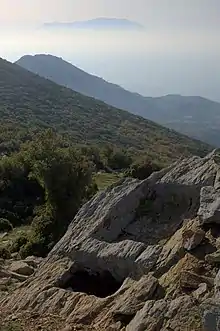Ismarus (Thrace)
Ismarus or Ismaros (Ancient Greek: Ἴσμαρος) was a city of the Cicones, in ancient Thrace, mentioned by Homer in the Odyssey.[1]
Homeric Ismarus
After their departure from Troy, Odysseus and his companions stop at Ismaros.[2] They sack the town, and attack the Cicones, the inhabitants of the adjacent region. They kill the men and divide the women and treasures among themselves, then begin to feast, despite Odysseus' advice that they leave immediately. The Cicones, who have left in search of help, come back in the morning in great numbers. Odysseus manages to escape, although he loses several men in the process. He embarks with the survivors and continues his journey home to Ithaca.
While at Ismaros, Odysseus spares Maron, the son of Euanthes and the priest of Apollo, and his family. Because of this, Maron gifts him a "goatskin bottle of black wine", some gold, and a mixing bowl. The wine was a strong and divine drink, as for each cup of wine, 20 times as much water was added to it to dilute it. He uses this wine to lull the Cyclops Polyphemus to sleep.[3]
Historic Ismarus

Ismarus was situated on a mountain of the same name, east of lake Ismaris, on the southeast coast of Thrace.[4] The district about Ismarus produced wine which was highly esteemed.[5] Pliny the Elder refers to the town as Ismaron;[6] Virgil refers to it as Ismara.[7]
Although Lake Ismaris is identified with the modern Lake Mitrikon; Ismarus' site is unlocated.[8]
References
- Homer. Odyssey. Vol. 9.40, 198.
- The Essential Homer: Selections from the Iliad and the Odyssey by Homer and Stanley Lombardo, page 299: "... From Ilion the wind took me to the Cicones In Ismaros. I pillaged the town and killed the men."
- Homer (2007). The odyssey of Homer. New York, NY: Harper Perennial Modern Classics. ISBN 978-0-06-124418-6.
- Virgil El. 6.30, Georg. 2.37; Propert. 2.13.5. 3.12.25.
- Athenaeus, Deipnosophistae 1.30; Ovid, Metamorphoses 9.641; Stephanus of Byzantium. Ethnica. Vol. s.v.
- Pliny. Naturalis Historia. Vol. 4.18.
- Virgil. Aeneid. Vol. 10.351.
- Richard Talbert, ed. (2000). Barrington Atlas of the Greek and Roman World. Princeton University Press. p. 51, and directory notes accompanying.
![]() This article incorporates text from a publication now in the public domain: Smith, William, ed. (1854–1857). "Ismarus". Dictionary of Greek and Roman Geography. London: John Murray.
This article incorporates text from a publication now in the public domain: Smith, William, ed. (1854–1857). "Ismarus". Dictionary of Greek and Roman Geography. London: John Murray.
- Durando, Furio. Greece, a guide to the archaeological sites (2004).